Nov 29, 2025
Nov 29, 2025
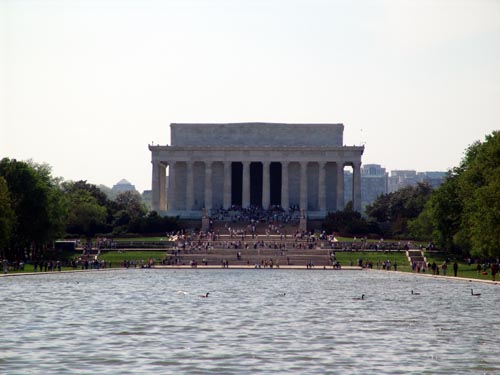 During our short trip to Gaithersburg, MD where I had gone to visit my daughter, we found time yesterday, (24th April, 2004) to revisit the Lincoln Memorial in Washington DC. This shot was taken by zooming in from the far end of the pond full of water.
During our short trip to Gaithersburg, MD where I had gone to visit my daughter, we found time yesterday, (24th April, 2004) to revisit the Lincoln Memorial in Washington DC. This shot was taken by zooming in from the far end of the pond full of water.
Located on the National Mall in Washington, DC, the Lincoln Memorial honors Abraham Lincoln, the 16th President of the United States. Lincoln was President during the Civil War (1861-65). The memorial, which was built between 1914 and 1922, symbolizes his belief that all people should be free.
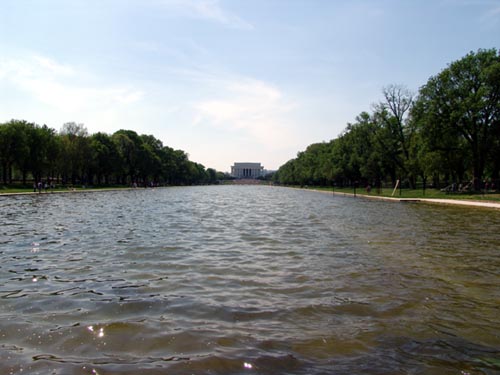
This long shot was taken from the far end of the pond full of water. Behind me is a new circular World War II memorial that was underway when I visited the Memorial for the first time in September 2003 seen in the next image.
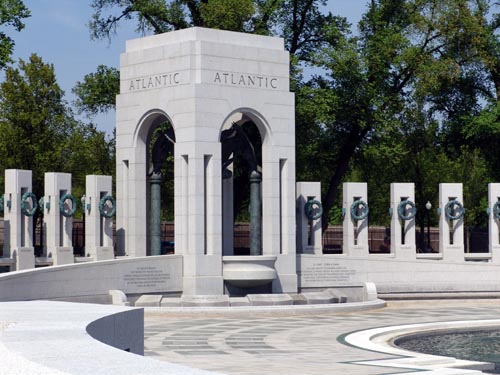 The new circular construction at the main entrance of the Lincoln Memorial is actually a World War II memorial. The photograph is taken with my back to the Lincoln memorial.
The new circular construction at the main entrance of the Lincoln Memorial is actually a World War II memorial. The photograph is taken with my back to the Lincoln memorial.
The inscription on the left of the main "Atlantic" column reads: "We are determined that before the sun sets on this terrible struggle our flag will be recognized throughout the world as a symbol of freedom on the one hand and of overwhelming force on the other", while the inscription on the right reads: "D-Day June 6, 1944 – You are about to embark upon the Great Crusade toward which we have striven these many months. The eyes of the world are upon you. I have full confidence in your courage, devotion to duty and skill in battle. "
On the blocks below the main "Atlantic" column are inscribed the names of various countries at war. The smaller columns on the sides are engraved with the names of various states of the US.
 In the second arc of the circular World War II memorial, the main column is engraved "Pacific" and the inscription on the left of the column reads:
In the second arc of the circular World War II memorial, the main column is engraved "Pacific" and the inscription on the left of the column reads:
"Battle of Midway June 4-7, 1942. – They had no right to win yet they did, and in doing so they changed the course of a war. Even against the greatest of odds, there is something in the human... A magic blend of skill, faith and valor - that can lift men from certain defeat to incredible victory."
while the inscription on the right of the "Pacific" column reads:
"The War's End – Today the guns are silent. A great tragedy has ended. A great victory has been won. The skies no longer rain death - the seas bear only commerce - Men everywhere walk upright in the sunlight. The entire world is quietly at peace."
On the blocks below the main "Pacific" column are inscribed the names of various countries at war. The smaller columns on the sides are engraved with the names of various states of the US.
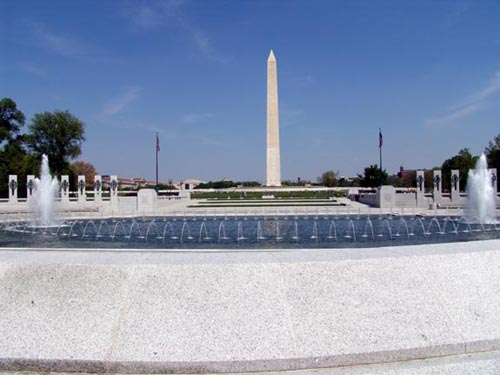
The central part of this memorial is predominantly a fountain. There are some more inscriptions which, however, were not readable from the place where I was standing and taking photographs. From this vantage point, however, I could capture the Washington monument standing in all its glory
 While walking on the sidewalk of the pond towards the Lincoln memorial, this duckling caught my eye and I could not help but click.
While walking on the sidewalk of the pond towards the Lincoln memorial, this duckling caught my eye and I could not help but click.
New York architect Henry Bacon modeled the memorial in the style of a Greek temple. The classic design features 36 Doric columns outside, symbolizing the states in the Union at Lincoln's death.
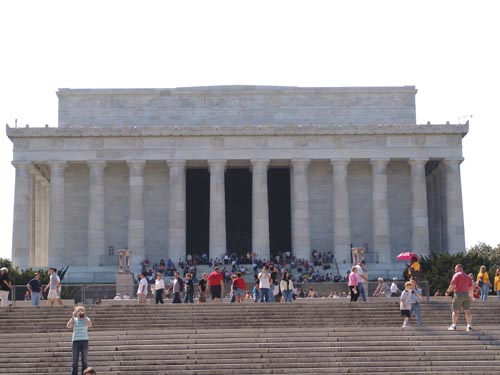
The building measures 204 feet long, 134 feet wide, and 99 feet tall, with 44-foot columns. It blends stone from various states: white Colorado marble for the exterior, Indiana limestone for the interior walls, pink Tennessee marble for the floor, and Alabama marble for the ceiling.
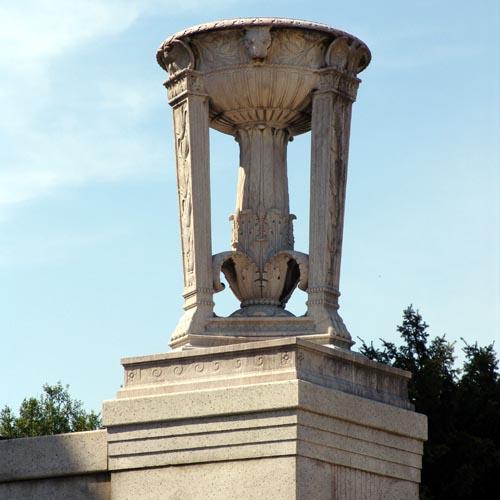 The names of the 48 states in the Union (when the memorial was completed in 1922) are carved on the walls along the outside of the memorial.
The names of the 48 states in the Union (when the memorial was completed in 1922) are carved on the walls along the outside of the memorial.
A plaque honoring Alaska and Hawaii is in the approach plaza.
This photograph I took at the first step ascending towards the Memorial. Viewed very closely, one can get a hint of Lincoln's statue inside. Also there are two artistic "neol posts" placed in line with the fourth column from the left and the right enhancing the entrance. In the next picture I have tried to capture one of them very closely.
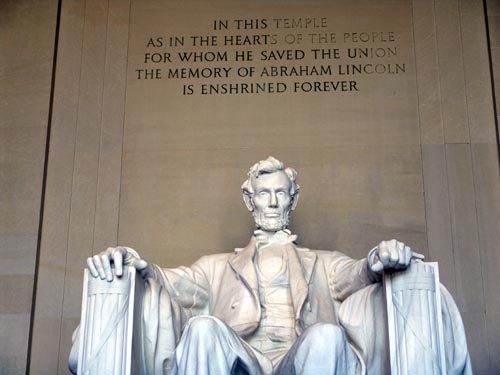
As one enters the memorial one is totally overwhelmed by the chamber where Lincoln's statute seated, facing the Washington Monument and the Capitol brings alive the history of the 16th president of United States. The statue of Lincoln is 19 feet high and weighs 175 tons. The atmosphere, both inside and outside the Memorial, is serene and peaceful.
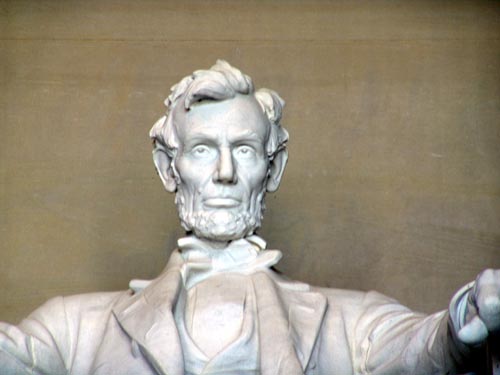 Abraham Lincoln was born on February 12, 1809, in a log cabin near Hodgenville, Kentucky, and became the 16th President of the United States, leading his country through
Abraham Lincoln was born on February 12, 1809, in a log cabin near Hodgenville, Kentucky, and became the 16th President of the United States, leading his country through
Lincoln's life was full of personal tragedy and disappointment, but his belief in the principles of the Declaration of Independence and his experience gained as a state legislator, a lawyer, and as a Congressman, along with a whimsical sense of humor, gave him the strength to endure. Throughout his political career Lincoln strove to maintain the ideals of the Nation's founders. He saw slavery as hypocritical for a Nation founded on the principle that "all men are created equal." In an 1854 speech he said: "I hate it [slavery] because it deprives our republican example of its just influence in the world - enables the enemies of free institutions, with plausibility, to taunt us as hypocrites." As President he used the power of the office to preserve the Union. In freeing the slaves, Lincoln left a legacy to freedom that is one of the most enduring birthrights Americans possess.
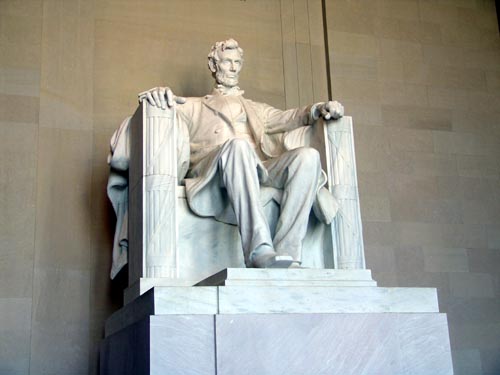 By condemning slavery's expansion and maintaining that he would not interfere with it where it already existed, Lincoln won the presidential nomination of the Republican party in 1860. Upon his electoral victory, seven states of the lower South seceded and formed the Confederate States of America.
By condemning slavery's expansion and maintaining that he would not interfere with it where it already existed, Lincoln won the presidential nomination of the Republican party in 1860. Upon his electoral victory, seven states of the lower South seceded and formed the Confederate States of America.
At his inauguration in March 1861 Lincoln implored the South to show restraint and tried to dispel its mistrust, but he also pledged to do whatever was necessary to preserve the Union.
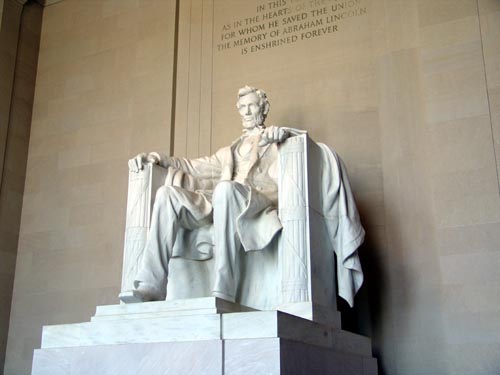 The South responded by firing on Fort Sumter in Charleston harbor, April 12, 1861. Lincoln, in turn, issued the call for troops to put down the rebellion, and four more states in the Upper South - Virginia, Arkansas, North Carolina, and Tennessee - seceded. The result was four years of bloody conflict.
The South responded by firing on Fort Sumter in Charleston harbor, April 12, 1861. Lincoln, in turn, issued the call for troops to put down the rebellion, and four more states in the Upper South - Virginia, Arkansas, North Carolina, and Tennessee - seceded. The result was four years of bloody conflict.
In January 1863 Lincoln issued the Emancipation Proclamation to free slaves within the states in rebellion, thus raising the war to a higher moral plane. In January 1865 he secured Congressional approval of the 13th Amendment that abolished slavery in the United States. In his second Inaugural Address, March 4, 1865, Lincoln offered peace and reconciliation to the South. He was shot by an assassin on April 14, 1865, and died the next day, six days after the surrender of Gen. Robert E. Lee and his troops at Appomattox Court House, Virginia.
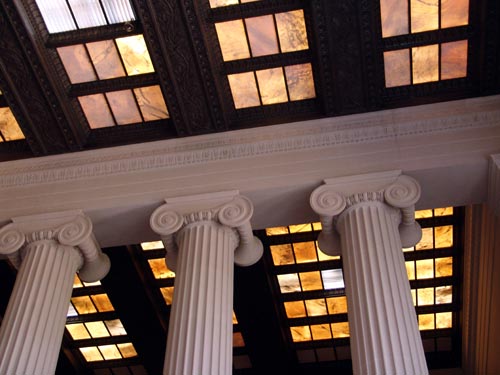
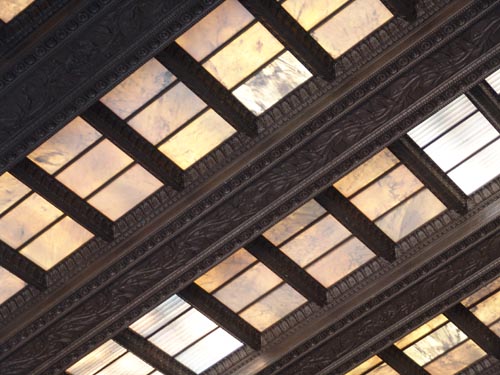
The interior of the Memorial is divided in 3 parts by majestic columns. The central part is the chamber where Lincoln's memory is enshrined in the form of his statute. A close-up of the ceiling.
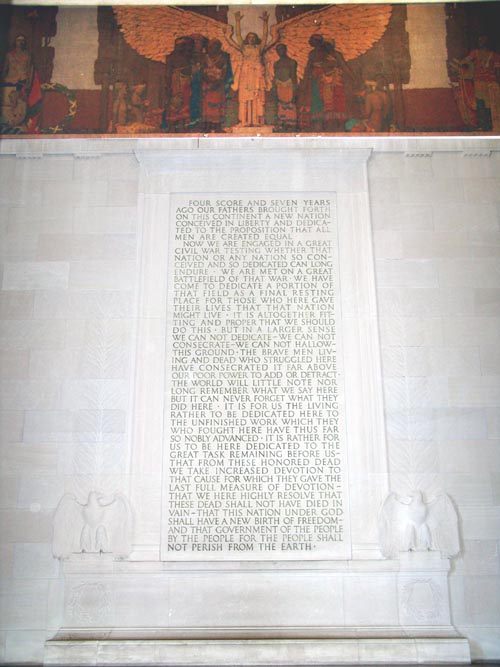
The Gettysburg Address
Four score and seven years ago our fathers brought forth on this continent, a new nation, conceived in Liberty, and dedicated to the proposition that all men are created equal.
Now we are engaged in a great civil war, testing whether that nation, or any nation so conceived and so dedicated, can long endure. We are met on a great battle-field, as a final resting place for those who here gave their lives that that nation might live. It is altogether fitting and proper that we should do this.
But, in a larger sense, we can not dedicate – we can not consecrate – we can not hallow – this ground. The brave men, living and dead, who struggled here, have consecrated it, far above our poor power to add or detract. The world will little note, nor long remember what we say here, but it can never forget what they did here. It is for us the living, rather, to be dedicated here to the unfinished work which they who fought here have thus far so nobly advanced. It is rather for us to be here dedicated to the great task remaining before us - that from these honored dead we take increased devotion to that cause for which they gave the last full measure of devotion - that we here highly resolve that these dead shall not have died in vain - that this nation, under God, shall have a new birth of freedom - and that government of the people, by the people, for the people, shall not perish from the earth.
Abraham Lincoln
November 19, 1863
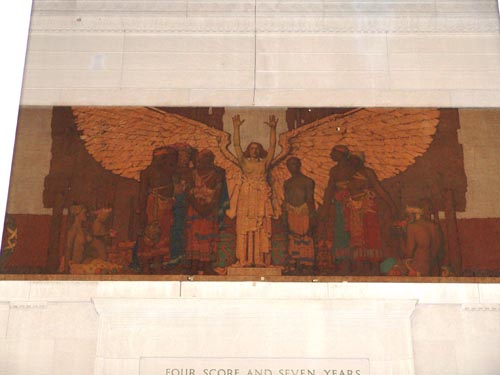
Mural above the Gettysburg Address
The mural painting "Emancipation" above the Gettysburg Address was painted by Jules Guerin between 1916 and 1919 is 60 feet long by 12 feet high. The mural shows an Angel of Truth freeing a slave, and is surrounded by representations of Justice and Immortality. Image shown here is only the central part of the mural.
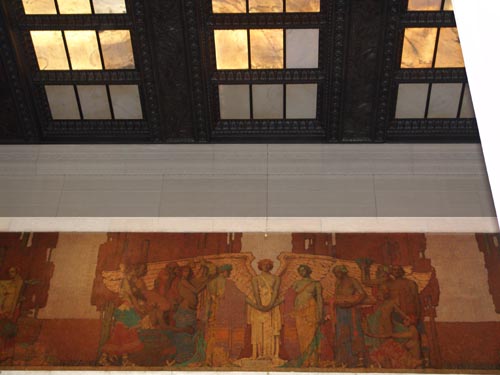
Mural above the 2nd Inaugural Address
"Reunion" the second mural is positioned above the 2nd Inaugural address of Abraham Lincoln. Both the murals are composed of three groups. The groups represent different aspects of the main themes such as "Freedom and Liberty", "Justice and Law", "Immortality", "Unity", "Fraternity", and "Charity" and are allegorical in nature. Image shown here is only the central part of the mural.
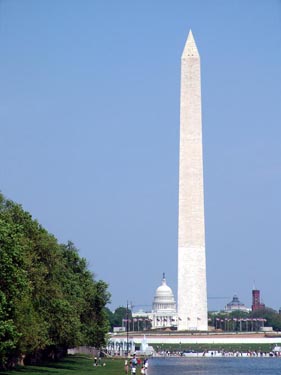 After visiting the Lincoln Memorial we started our long walk back to pick up our car from the garage. On the way I took some more photographs. This one shows the Washington monument and the Capitol in the background.
After visiting the Lincoln Memorial we started our long walk back to pick up our car from the garage. On the way I took some more photographs. This one shows the Washington monument and the Capitol in the background.
Washington Monument : Designed by Robert Mills (b. Charleston, S.C., Aug. 12, 1781, d. Mar. 3, 1855) in 1838, to follow the form of an Egyptian obelisk, it rises more than 168 m (550 ft) above the city and is the largest masonry structure in the world.
The actual construction of the monument began in 1848 and was not completed until 1884, almost 30 years after the architect's death, due to lack of funds and the intervention of the Civil War. A difference in shading of the marble (visible approximately 150 feet up) clearly delineates the initial construction from its resumption in 1876.
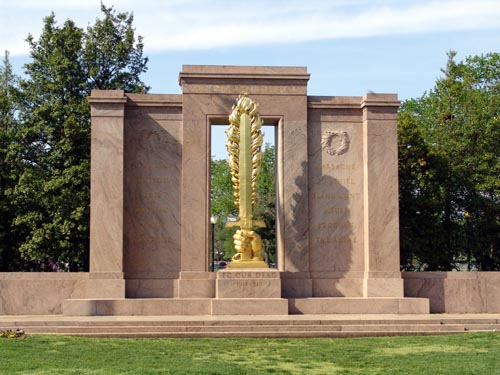
Dedicated to "Our Dead: 1917-1919" from the Second Division. This is on way from the Lincoln Memorial to the White House.
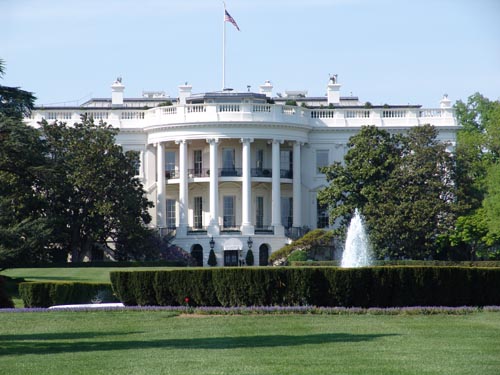
The White House
The White House is the oldest public building in the District of Columbia, and 1600 Pennsylvania Avenue is the most famous address in the United States. Here every President, except George Washington, has conducted the government of the Nation. In the past 200 years, the White House has become symbolic of the American Presidency throughout the world. While the Capitol represents the freedom and ideals of the Nation, the White House stands for the power and statesmanship of the chief executive.
24-Apr-2004
More by : Rajender Krishan